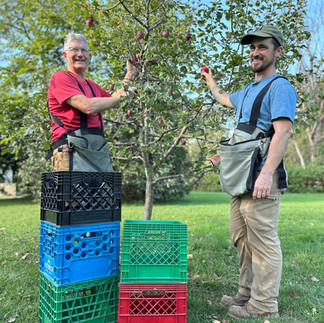The Magic, Art and Chemistry of Blending Artisanal Vinegar: Why so many varieties of apples?
- Jeff Turner (PhD)

- Jul 23
- 2 min read
At St. Eugene Vinegar Co. we grow 38 different kinds of apples.
Surely, we could get by with just a few? Well, no, actually! For those of you seeking an extraordinary taste experience, read on.
Why apple variety is important for superior artisanal vinegar
Balancing the tannins, sugar and acidity in apple juice is central to making an elegantly complex dry cider beverage and superior vinegar! Achieving this liquid magic requires the proper blend of many different kinds of apples - each contributing a different flavour, acid and tannin profile.

But, where to start?
In 1902, Britain’s apple scientists at the Long Ashton Research Station established a system of apple classification to aid cider/vinegar makers (Franch and Spain have similar systems) based on an apple’s sweetness (sugar), bitterness (tannins) and sharpness (acidity). (Jolicoeur 2013).
Apples were placed into four groups;
Sweet
Bittersweet
Sharp
Bittersharp
Adding 'spitters' changes everything
British cider making tradition involves using specialized apples known as “spitters” – think crab apples - because their high tannins make them unpleasant to eat raw. Tannins are compounds found mostly in the skin of apples and grapes that are released into the juice during pressing. Tannins produce sensations of astringency – a drying or puckering sensation in the mouth. This perception of dryness is caused when tannins bind to the lubricating proteins in your saliva (McRae and Kennedy, 2011).
It’s not a taste, rather a feeling - which, at the proper level - adds complexity, body and structure that lingers pleasantly in the mouth. Without tannin everything appears thin and weak. Tannins also show bitterness as they interact with your tongue’s bitter receptors. Again - at the proper level - bitterness in cider/wine is pleasantly thirst quenching. So, as you consume our vinegars, recognize and enjoy the rich difference that tannic complexity and long finish make!

“Sweet” apples contain ample sugar but are low in acid and tannins content.
Most dessert apples you buy in the store are designated sweet. Available by the ton, they are often used industrially to manufacture bulk distilled vinegar for pickling and household cleaning uses. Artisanal vinegar makers, like St. Eugene Vinegar Co., use sweet apples in our blend, but just enough to insure sufficient acetic acid is formed (June 18, 2025 blog).
Acidity in apples is typically 90% malic acid.
Acidity is important in cider for a crisp, clean taste but less important in apple cider vinegar (ACV) because the acetic acid predominates.
At St. Eugene Vinegar Co. we appreciate the rich flavour and taste sensations that all our different apple varieties provide. Think about it the next time you taste our vinegar.

References
Jolicoeur, Claude (2013) In “The Cider Maker’s Handbook”, Chelsea Green Publishing, White River Junction, VT USA
McRae, J.M. and J.A. Kennedy (2011) Wine and grape tannin interactions with salivary proteins and their impact on astringency: a review or current research. Molecules 16: 2348-2364

















Comments